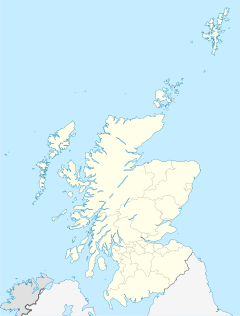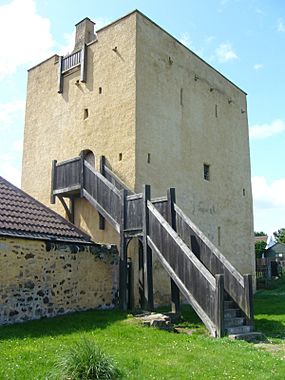Liberton, Edinburgh facts for kids
Quick facts for kids Liberton |
|
|---|---|
 Liberton Kirk |
|
| OS grid reference | NT274696 |
| Council area |
|
| Lieutenancy area |
|
| Country | Scotland |
| Sovereign state | United Kingdom |
| Post town | EDINBURGH |
| Postcode district | EH16 |
| Dialling code | 0131 |
| Ambulance | Scottish |
| EU Parliament | Scotland |
| UK Parliament |
|
| Scottish Parliament |
|
Liberton is a lively area in the south of Edinburgh, the capital city of Scotland. It sits south of The Inch, east of the Braid Hills, and west of Moredun.
The local Community council for Liberton also covers nearby places. These include Gracemount, Kaimes, Alnwickhill, and Mortonhall. In the past, the Liberton area was much larger. It included places like Burdiehouse, Gilmerton, Niddrie, and Straiton.
Liberton became part of Edinburgh in 1920. A famous writer, Arthur Conan Doyle, once lived here. His small cottage was near the Braid Burn. Today, this spot is inside the Cameron Toll Shopping Centre car park. It is now a small school.
Since the mid-1970s, Liberton has grown a lot. Many new homes have been built. Areas like Double Hedges, Alnwickhill, and Howdenhall are popular. They often offer good value compared to places closer to the city centre.
Some community pubs and hotels have closed recently. Places like the Liberton Inn and The Marmion are now shops or flats.
Contents
What Does the Name Liberton Mean?
The name Liberton comes from Old English. It was once spelled Libertun. For a long time, people thought it meant 'Leper Town'. They believed a small group of lepers lived here, away from the city.
However, experts now think it might mean 'barley farm on a hillside'. This comes from the Old English words hlith (hillside) and bere-tūn (barley farm).
This old rural area was split into two parts. These were Over Liberton and Nether Liberton. Nether Liberton was known for a water mill on the Braid Burn.
Discovering Liberton's Past
Liberton is home to a very old standing stone. This stone is over 6 feet tall. It has been there since prehistoric times.
In 1143, a chapel in Liberton was given to the monks of Holyrood Abbey. This gift came from MacBeth, who was the Baron of Liberton. King David I's old papers from 1124 also mention MacBeth.
In 1240, the church was moved back to Holyrood Abbey. It had been with St Cuthberts in Edinburgh. Holyrood Abbey kept control until the Reformation.
By the time of the Reformation, a church already stood in Liberton. It was named after the Virgin Mary. This church was also controlled by Holyrood Abbey.
The current Liberton Church was built in 1815. It was designed by James Gillespie Graham. The old church had been badly damaged by fire. In the churchyard, there is a special "table stone." It has one of the oldest pictures of ploughing ever found. A newer cemetery is next to the old churchyard. The war memorial at the entrance was built in 1920. It was designed by Pilkington Jackson.
Liberton Tower is a well-kept old tower house. It was built in the 15th century. It stands south of the Braid Hills. Nearby is Liberton House. This is a fortified house from the late 16th century. It has also been restored. You can visit Liberton House by making an appointment.
Liberton officially became part of Edinburgh on November 1, 1920.
Liberton Today: Schools and Activities
Liberton is mostly a place where people live. But it also has a riding school and stables. These places use the nearby Braid Hills for pony trekking.
The area has several schools. These include Liberton High School, Gracemount High School, and primary schools like Liberton, St John Vianny, Gracemount, and St Katherine's.
For sports, there is the Liberton Bowling Club. It is located across from the Kirk. There is also a Golf club off Gilmerton Road. A Rugby Union club plays at Double Hedges Park.
Southfield Sanatorium was once located at Southfield House. Later, Ellen's Glen House community hospital was built there in 2000. This hospital helps meet the needs of NHS Lothian. Liberton Hospital opened in 1906. It now specializes in care for older people.
Liberton Cemetery: Notable People
The Liberton Cemetery and Kirkyard is the resting place for many people. Some local family names found here include Speedy, Flockhart, Inch, and Torrance.
People Buried in Liberton Cemetery
- Tom Aiken (1872–1943): A Scottish billiards champion.
- William Inglis Clark (1855–1932): A chemist and mountaineer.
- Arthur Robertson Cushny (1866–1926): A physiologist, who studied how living things work.
- Henry John Dobson (1858–1928): An artist. His sons, Henry Raeburn Dobson and Cowan Dobson, also became artists.
- Professor Robert Flint (1838–1910): A theologian and philosopher.
- Charles Edward Green (1866–1920): The author of a book called the Encyclopaedia of Agriculture.
- A monument for children who died at Dr Guthrie's School.
- Reverend George William Jones (1879–1918): An academic who died as a pilot in the First World War.
- Sir John McNeill (1795–1883): A diplomat.
- Robert Payton Reid (1857–1945): An artist.
Other Famous Residents of Liberton
- James Goodwillie (1866–1953): A mathematician who was born and grew up in Liberton.
- Archie Scott (1918–2019): A first-class cricketer.
Fun Fact About Liberton
Dunedin, New Zealand, is a sister city to Edinburgh. It also has a suburb named Liberton.
See also
 In Spanish: Liberton para niños
In Spanish: Liberton para niños





